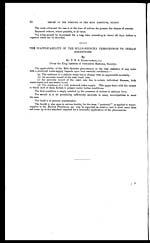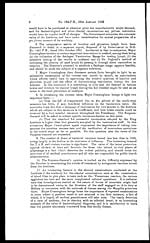Medicine - Institutions > Reports from medical colleges, schools and research institutions > Report of the King Institute of Preventive Medicine, Guindy > Reports on the working of the King Institute of Preventive Medicine, Guindy for the official year 1921-22 and the Micro-biological Section for the period from 1st January to 31st March 1921
(41) [Page 1]
Download files
Individual page:
Thumbnail gallery: Grid view | List view
![(37) [Page 1] -](https://deriv.nls.uk/dcn17/7493/74936452.17.jpg)
Government [NLS note: a graphic appears here - see image of 74936452.tif]of Madras
LOCAL SELF-GOVERNMENT (PUBLIC HEALTH) DEPARTMENT
G.O. No. 154-P.H., 29th January 1923
Report—King Institute, Guindy—Working from 1st January 1921 to 31st March
1922—Reviewed.
Order—No. 154-P.H., dated 29th January 1923.
Up to the end of the calendar year 1920, the report on the Micro-Biological
Section of the King Institute was dealt with separately from that of the Vaccine
Section, as required in G.O. No. 892 L., dated 26th July 1906, the former cover-
ing the work done during the calendar year, the latter that of the official year.
Under G.O. No. 43-P.H., dated 6th January 1922, the working of the two
branches has been summarized in a single consolidated report coinciding with the
official year. A separate report has been submitted for Micro-Biological Section
for the broken period January to March, 1921.
2. In his introductory remarks the Director differentiates clearly between the
five main functions of the Institute. Not only is the Institute (1) a vaccine
lymph factory, but it is also a collection under a single roof of laboratories for
(2) the manufacture of bacterial vaccines, (3) examination of clinical material, (4)
public health work and (5) research. It is also a depot for the storage and distri-
bution of anti-toxic sera for use throughout the Presidency.
3. In the first section of the report, Major Cunningham discusses the decrease
in the quantity of vaccine lymph issued, no less than 22,405 cases less than in
the previous year. The prima facie reason for this decline is the stoppage of
routine vaccination during the hot weather months. The obvious remedy is to
intensify the vaccination campaign during the cooler months. It is satisfactory
to note that "a large proportion of those who were not vaccinated in the hot
weather months presented themselves for vaccination during the cooler months."
Major Cunningham estimates in a later paragraph that 144,475 cases, which
would under ordinary circumstances be vaccinated in the hot weather, were
transferred to the cold weather, while the increase in the success rate was such
that the expense and trouble for carrying out over 42,000 unsuccessful operations
have been saved. This stoppage has been amply justified not only by these eco-
nomies but also by its remarkable rise in the success rate from 66 per cent to 75
per cent.
4. The importance of ascertaining the results of vaccination operations with
completeness and accuracy cannot be overrated. The results of no less than 40.7
per cent of the lymph issued are not known. It is worth considering whether
the military authorities and private bodies should not be required to furnish the
Director with returns regarding the number of operations performed and the
success achieved as a condition to obtaining lymph from Guindy.
5. As a factory the Institute undoubtedly effects a substantial saving in
public expenditure. Major Cunningham attempts to estimate the profits of
the Institute as a whole which he places at Rs. 1,10,280. Against a total
expenditure of Rs. 2,00,204 he takes credit for Rs. 1,14,375 for the value of the
vaccine lymph issued and Rs. 1,72,513 for the value of the bacteriological exa-
minations, etc., and Rs. 23,596, the value of bacterial vaccines supplied, the total
of the credit of the Micro-Biological section being Rs. 1,96,109 and for the Insti-
tute as a whole Rs. 3,10,484. But for the existence of the Institute the vaccine
Set display mode to: Large image | Zoom image | Transcription
Images and transcriptions on this page, including medium image downloads, may be used under the Creative Commons Attribution 4.0 International Licence unless otherwise stated. ![]()
| Permanent URL | https://digital.nls.uk/74936450 |
|---|---|
| Description | G.O. No.154-P.H., 29th January 1923 |
| Description | 13 titles. Describes research work and conditions, treatments, vaccine production, medical education, public health and disease outbreaks. Extensive tables show mortality rates and patient admissions. These - some from asylums, jails, dispensaries, civil and police hospitals – will be useful to epidemiologists. |
|---|




